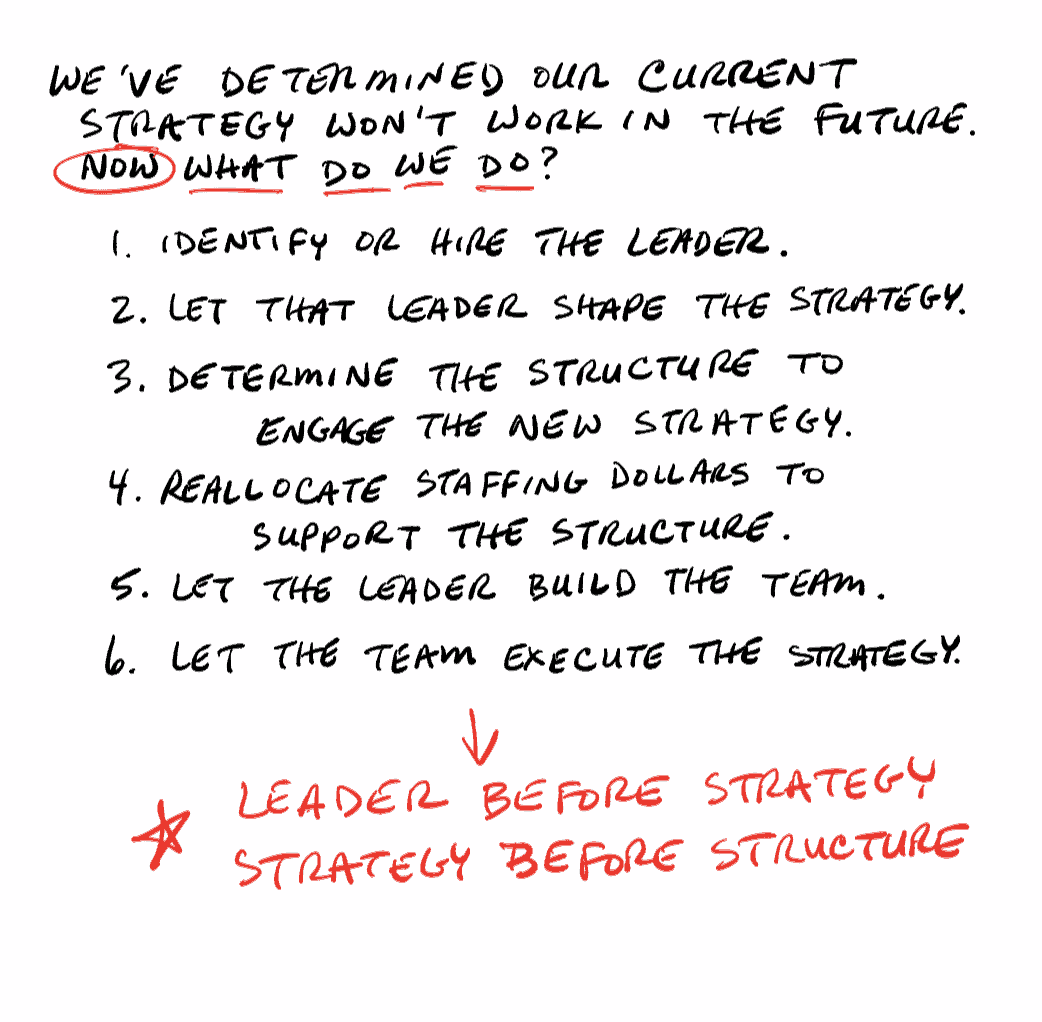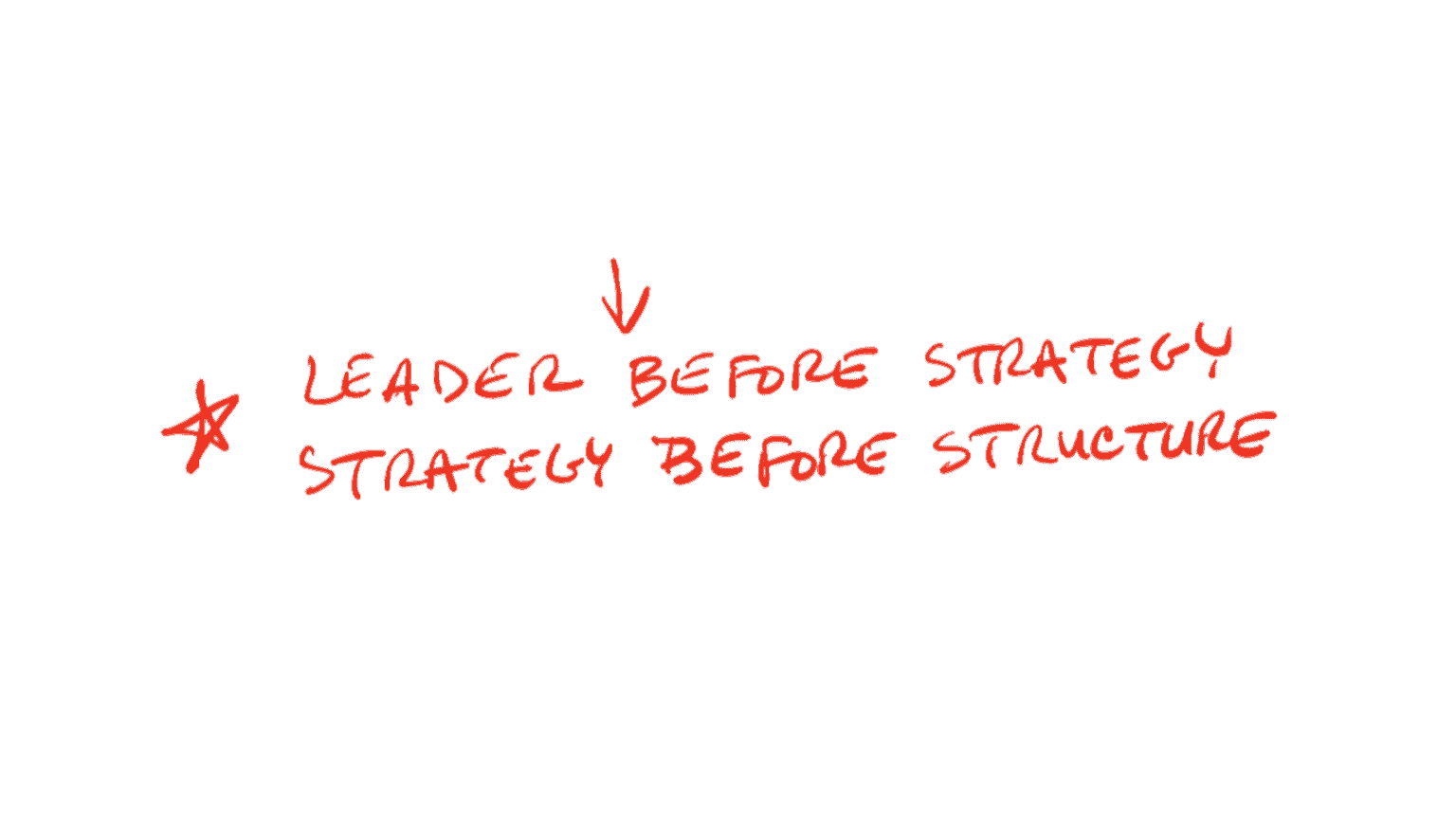How to Structure and Staff for More Digital Ministry + 6 Steps to Sequence the Shift Effectively
If you enjoy this episode, subscribe on your device for more:
iTunes RSS Google Play Stitcher Spotify
The shift from analog to digital ministry is one of the biggest ministry strategy shifts churches are having to make right now. In truth, they needed to be making it before this crisis hit, but now it feels urgent.
We reported in our special edition of the Q2 2020 Unstuck Church Report, that 70% of larger churches told us they are thinking about how their staffing structure may need to shift permanently to prepare for the new normal.
But when we talk to pastors personally, you’re all asking us the same thing:
How do we do this?
And the hard part is, there aren’t really many examples out there. So as we’ve been helping churches process how to make these shifts, we’ve come back to a tried-and-true approach to evaluating and implementing any key ministry strategy shift.

In this conversation, Amy and I discussed…
- The #1 thing you MUST get right as you make shifts to do more ministry online
- What churches should be looking for in a Digital Ministry Director and where you find this person
- The right flow—the 6-steps in the right sequence—for making core ministry strategy changes
Leader Conversation Guide
Want to take this conversation back to a staff or senior leadership team meeting?
Our Show Notes subscribers get a PDF download that recaps the episode content and includes a discussion guide you can print out and use at an upcoming meeting.
Opt-in here and get the Leader Conversation Guide for this episode, as well as access to the archive.
Let Us Know on Social Media
We use #unstuckchurch on Twitter, and we start a real-time conversation each Wednesday morning when the episode drops.
You can follow me @tonymorganlive and The Unstuck Group @unstuckgroup. If Facebook is where you spend your time, I’m there, too.
Links & Resources from the Episode
- 7 Shifts Churches Need to Make Because of the Coronavirus
- Why Church Communications is Stuck in 2004 | Episode 61
- Clarifying Digital Engagement | Episode 144
- 4 Roles a Senior Pastor Can’t Delegate eBook
- The Key To Reaching NEW People in a Digital World | Episode 152
- The Change Cycle & How to Lead Your Church (and Yourself) Through It | Episode 153
Unstuck Leadership Coaching
Need guidance and support as your leading into this new normal?
We’ve developed a customized, holistic, one-on-one coaching experience designed to increase your capacity as a leader, help you lead change, and equip your team to be aligned and actively executing on the vision and mission of your church.
Through our Unstuck Leadership Coaching, we want to partner you with a coach that helps you grow your ability to effectively lead your team and your church to thrive in the new normal.
Write a Review—It Helps!
Particularly on iTunes, your ratings and reviews really do help more pastors discover the podcast content I’m creating here. Would you take a minute to share your thoughts? Just open the the podcast on iTunes on your phone or computer, click Ratings & Reviews, and leave your opinion.
Transcript
Sean (00:02): Welcome to The Unstuck Church podcast, where each week we’re exploring what it means to be an unstuck church. In response to the way our culture is changing around us, churches are beginning to shift as well. One of the key changes they’re making is moving from analog to digital ministry. Today, Tony and Amy are going to talk you through the one step that you have to get right as you do more ministry online. But before we get to today’s conversation, I want to ask, are you concerned that people might not be coming back to church? For the churches who’ve reopened, they’re seeing a 75 to 80% decrease in attendance. If you’re unsure of what your ministry needs to look like to reach people in the next normal, I want to invite you to join us for a brand new Masterclass designed to help you reach more people online and lead a thriving church. It happens July 30, and Tony and our team will bring a fresh perspective, present clear action steps and create a deeper understanding of how to implement the shifts your church needs to make in order to survive and thrive in the new reality. Go to theunstuckgroup.com/masterclass for more information and to register today. Now let’s join Tony and Amy for this week’s conversation.
Amy (01:13): Well, Tony, you mentioned a few weeks ago that 70% of larger churches are thinking about how their staffing structure may need to shift to prepare for the new normal. So obviously a key area that these churches are trying to figure out relates to digital ministry, staffing and structure. What was your original reaction when you saw that stat from our last survey?
Tony (01:33): Yeah, the stat was 70%. Is that right?
Amy (01:35): That’s right.
Tony (01:36): Yeah. My initial reaction, why isn’t it a hundred percent because I mean, this is a needed shift. Churches, in order to reach our culture and this is pre-COVID, but it’s going to be even more so, given what we’ve experienced in recent months, churches need to make this shift from analog to digital. We need to get to the place where, as ministries, we are becoming online churches, a digital ministry strategy is in place and we offer in-person options, rather than the other way around, which is the way church has operated in the past. And again, it’s just, this is an essential shift that every church needs to make. Or another way of looking at this, we need to become an online church rather than a church with online services. And because of that, in most cases, Amy, I don’t know that I can name a church really, that has this role in place now. We need to prioritize hiring a digital ministry pastor or director, whatever you call this person, before we hire the online campus pastor, as an example. So almost every church has work to do in this area to prepare for the new normal that our churches are going to be trying to engaging. And because of this, is one of those key shifts that churches need to be focused on. And speaking of that, you’ll want to hang on until the end of this episode, because we’re going to share about a new opportunity we have for leaders who are trying to figure out how they’re going to lead through change, to reach more people in this new normal. But Amy, you’ve been helping churches think about this new digital ministry director, pastor or whatever we call it. This has been something that’s been a part of a lot of conversations you’ve been having in recent weeks with churches. So how are you coaching churches to think about this new role?
Amy (03:39): Yeah. Well, let me just start with where they’re starting. They’re thinking we need someone who can make our service digitally online. So it’s people kind of buried in that weekend service area. It’s the person who knows how to convert video or maybe has some creative ideas related to how to make that online service better. But honestly, that’s not the right starting place. This is not the person who manages the website or social media or communication. And this is not the person who is a videographer on our team. It’s really a bigger picture role because we want this person to develop and implement a digital strategy overall that’s going to engage and connect with people the church is trying to reach, and a digital strategy to help people in the congregation become more like Jesus, right? To take steps on the church’s discipleship pathway. So it’s much more holistic. One of the concepts that we’re using a lot is called content marketing. And that’s going to be a big piece of what this person is going to lead. They’re going to ask things like, who are we trying to reach? What are their needs? What do they value in life? What are the key questions are asking? Really developing that persona of who’s in that community they’re trying to reach. And then the digital leader is going to go, you know, how do we respond then to help people take their next step that we’re trying to reach? So, and one last thing, this leader and this team will have to work closely, obviously with the leaders over the weekend environment, will have to work closely with the Next Gen environments and the discipleship teams, because we aren’t just trying to digitally put our service out there. It’s what we just said, we not only want to reach them and help them take next steps digitally, we want to help people who already follow Jesus, take next steps digitally as well.
Tony (05:27): And because of all of that that you’re describing, Amy, this sounds like a big responsibility. So what should churches be looking for? And where do you find this person?
Amy (05:38): Yeah, that is the headline question, isn’t it? Well, let me just first start out, of course you want someone who loves Jesus and loves your church, loves the church, loves the mission. But for these types of roles, it’s often more important to find someone who is a leader and a strategic thinker, rather than a faithful doer. So someone who’s got the gift of leadership, and maybe that’s not hard to swallow, but this next one might be where it gets a little weird for churches, but the ideal person is probably familiar with inbound marketing strategies and/or digital sales and marketing functions. So most likely the best person is already doing this somewhere in the marketplace. And that makes us uncomfortable sometimes because we’ll say church is not a business. It isn’t, but we have a mission. And we’re going to look at digital as a strategy. And you want someone who understands that world. I don’t think you’re likely, by the way, to find this person already on your church staff team. More than likely, they’re happily employed somewhere in the marketplace, making a little bit of money out there, and like me and you, God’s about ready to interrupt their world and call them into ministry. So, and it sounds hard, but it’s not. Honestly, there are so many positions in the marketplace that have this role. The marketplace is amazing at reaching me digitally. I don’t know about you, but they’ve been doing digital content and strategies for decades. So given how many businesses have already made this leap, the odds are pretty good that you’ve got someone in your church who’s already engaged in this in their marketplace world.
Tony (07:15): Yeah. In fact, Amy, I was just having a conversation yesterday with another friend in ministry. And we were talking about this very topic of how in the past, it was a bit challenging to talk with churches about how they could leverage some of the tools that are available to reach new people in their communities and encourage people to take their next steps toward Christ. And you just alluded to this, the reality is we’re all living in that world, including those of us that are in ministry, every aspect of how we live our life, the organizations that we interact with, even those we didn’t know we wanted to interact with, they’re leveraging these tools to make a connection with us and to encourage us to take a next step. The only difference is they’re wanting to sell us something, a product or service. We want people to hear the good news, and to give their life to Jesus and to take steps toward Jesus. So I’m excited about this conversation, that’s for sure.
Amy (08:15): Well, I’m glad we’re starting it about talking about the leader first, because that’s not necessarily where our team even started talking about this conversation a couple of months ago. Catch our listeners up to speed on where we started.
Tony (08:27): Well, I mean, we’re starting to recognize as a team, there’s a big shift that’s required here from analog to digital. And because we have a lot of problem solvers on The Unstuck Team, I think our first instinct was to help churches actually create their new digital ministry strategy. Do you remember these conversations, Amy?
Amy (08:47): We wanted to solve that problem, yes.
Tony (08:49): And that seemed like the obvious thing to do, especially since that’s really the primary strategy that The Unstuck Group has used to grow through the years. I mean, we recognize we have to connect with a broader audience of pastors and church leaders to encourage them to take a next step. And we’ve been using these digital strategies that we’re talking about today. We were thinking, let’s take what we’ve learned to grow our ministry and create a plug and play digital ministry strategy for churches.
Amy (09:25): That’s right, in hindsight, we’re going to look back and glad it wasn’t us.
Tony (09:27): Yeah, you’re right. So you might be asking the question then.
Amy (09:32): So Tony did we succeed at that?
Tony (09:35): No, we didn’t. Yeah. We came to the conclusion it’s really impossible to build a one size fits all digital ministry strategy for every church. I mean, it’s obvious, but churches are trying to reach different people in different communities. And though there are similarities, different churches actually use different discipleship strategies too to encourage people to become more like Jesus. The bigger challenge though, is that if we created that strategy, we’d actually have to execute that strategy for every church as well. And that’s obviously impractical, and it’s certainly not a sustainable model for us or for the churches that we serve, but it did get us thinking about the flow of how we need to encourage churches to process changes like this one. I mean, this is a big change, when it comes to shifting from analog to digital, but the reality is the same flow actually works for any significant change that a church needs to make related to its core ministry strategies.
Amy (10:40): Yeah. Well, I think I know where this is going. I’ve heard you say in the past, Tony, if you’re going to toss a new ball in the air, there better be somebody there to catch it.
Tony (10:50): That’s absolutely right.
Amy (10:50): So that’s where this digital ministry leader comes in. That’s the person who has to be positioned to catch the ball, right?
Tony (10:56): That’s right. And because the rest of us are already juggling other balls, sometimes more than we can handle. If we try to catch that ball, we’re talking about the digital ministry strategy in this case, then very likely we’re going to drop another ball. And so what we’re going to talk about here is really a flow or a process to think about core ministry changes in our churches. And we’re going to be talking about several steps here. So, rather than you trying to take notes as you’re listening, we’ll certainly include a visual in our show notes so that you don’t have to worry about getting this all down right now. But generally when, again, today we’re talking about a shift in digital ministry strategy that needs to occur, but this would apply to any area where we’re encouraging a church to make a significant change. And this is what the flow looks like. Step one is we decide whether or not we need to shift our ministry strategy. And in this case, we’re talking about shifting ministry strategy for a new normal. The second step is if so, if we need to make that shift, what are our core growth engines going to look like in the new normal? Is what we’re talking about a part of one of those core growth engines as a church, which is going to help us reach more people and help more people take their next steps toward Christ. The third step is this. Then if that’s the case, we need to identify or hire a leader over this key growth engine. The fourth step is then to let that leader help us shape the strategy for the future. And this is key. The sequence is important here. The fifth step is to determine what structure is needed to support that future strategy. And step six is to reallocate or shift staffing resources, if needed, to match the shift in ministry strategy. Now I know I just ran through those six steps pretty quickly. I’m going to circle back in a moment and give you a specific example of what this might look like, but here are the key thoughts behind the sequence. The first is you can’t build a structure without clarifying the strategy first. So you have to have your strategy in place, and then you can build a structure to support it. The second key thought is you can’t clarify the strategy until you have a leader to shape that strategy for you. And that’s actually an important piece that I see many churches kind of dropping the ball on this area because I don’t know, again, I think part of it is Amy. We just, as leaders, we’re natural problem solvers. I mean, we gravitate to problems. And because of that, it’s in our instinct to want to try to solve the problem, to create the strategy that’s needed. And in this case, when we’re talking about a significant shift to a core ministry area, you have to find the leader first before you start to craft the strategy. And the third key thought is you need that leader to help you build the team. It’s a mistake if you start building the team first, before you get the leader identified. So again, as promised, I want to again, walk through those six steps again, but this time we’re thinking about this shift to focus on digital ministry strategy. So the first step we would be, we would decide that our ministry strategy, actually, we need to embrace this change. We need to embrace this focus on moving from analog to digital. That’s the first step. The second step, we need to decide is digital strategy going to be one of the core future growth engines of our church. And honestly, in this season, Amy and I can’t foresee this ever changing. I just think this has to be a core piece of who you are as a church moving forward. In fact, you and I have been really pushing churches to think about this role, maybe not immediately, because you want to make sure the leader that you’re identifying lives up to the leadership capacity required, but very likely this position is going to be on your senior leadership team at some point in the near future. So that’s the second step is just to confirm, is this a core piece of who we we’re going to be as a church? The third step is to actually identify and hire the leader to be your pastor or director over digital ministry. You got to get that leader identified. Step four, then, would be to let that leader shape your digital ministry strategy. So the senior pastor shouldn’t do this. You shouldn’t just ask your worship leader to do this on the side. You shouldn’t figure out, is there a volunteer with a couple hours this week that they can start shaping it? No, you have to identify who is this leader going to be? Step four, we let that leader shape the ministry, the digital ministry strategy. Step five. Then that leader also helps us identify what the structure needs to look like. Here we’re thinking about both staffing structure and volunteer structure, to make sure the right team is in place to support this strategy. And then finally, we need to revisit our staffing investments to determine how we’re going to reallocate our staffing budget to support this new digital ministry strategy going forward.
Tony (16:42): And, Amy, I mean, this is a big deal. I mean, we’re going to have to identify new leadership, and in certain size churches, it’s going to require additional staffing to support this beyond the volunteer teams that will be built. And so we just can’t tack this on to the budget. I mean, I don’t know what church is in a financial position right now just to add this onto their budget, which means we’re going to have to have some tough conversations about how we’re going to shift financial resources so that we can begin to prioritize this in our ministry.
Amy (17:20): Yeah, I think you said this, but I’m just going to ask again for clarity. Why are those steps in that order so important?
Tony (17:25): Yeah, so, like we were trying to build a digital ministry strategy for churches earlier and laughing at that. We actually started to see pastors wanting to jump in and create their digital ministry strategy for their churches. And you just can’t do this. I mean, Amy, you and I have had a number of conversations in the last months about the roles that senior pastors can’t delegate to others. And the fact is if you try to step in and craft the strategy and then execute this digital ministry strategy and build all the teams to make that digital ministry strategy happen, one of those other balls that you’re juggling is going to get dropped, and that is going to be a significant impact on your ministry health. The other thing is you need the person who’s going to lead the strategy to help you design the strategy. And it sounds so obvious, but I’ve seen so many times where churches have kind of gotten ahead of themselves, and whether it’s digital ministry strategy or any other big shift they’re trying to make, they’ve kind of gotten ahead of themselves in trying to work on the strategy before they have the leader. And then with that, you need the person who will lead to help you build the team. Again, you can’t get ahead of yourself here. And I think a lot of times we are trying to save money. So we try to figure out who do we have on our team now that can do this? Who can support this? Or who are the volunteers that can help us make this happen? In big areas like this, core ministry areas like this, you have to get the person in place and then you have to build the team to actually get it done. So I thought it would be helpful, Amy, to maybe think about this beyond just the digital ministry conversation that were happening and to think about it in these teams. I mean, could you imagine if we approached other significant changes in our core ministries and didn’t follow this flow of steps that I’ve highlighted. As an example, let’s pretend instead of launching a new digital ministry strategy for our church, we were talking about ending our traditional worship and shifting to modern worship.
Amy (19:45): Alright. That sounds spicy. Let’s do that one.
Tony (19:47):
I mean, if you do this like we’ve seen some churches try to tackle this digital ministry strategy. Well, the senior pastor would just design the modern worship experience. I mean, we couldn’t imagine that happening, but that’s what would happen. And a lot of balls that senior pastor should be juggling would get dropped, or maybe we would look at it this way, we’re eliminating the traditional worship service, so we’ll just make the organ player the leader of the modern worship experience. And again, we couldn’t imagine doing this, but we’ve already seen some churches just say, well, we can’t focus on these ministry environments like we have in the past, we need to instead focus on our digital ministry strategies going forward. So we’ll just shift this team, these leaders, over now to our digital ministry strategy. Well that’s not going to work either. It’s just in this case, it’d be like saying the organist is more important than the mission we’re trying to accomplish as a church. Or it might be, here’s another way of looking at this, we can’t afford to hire someone for the modern worship experience, so we’ll just find all the volunteers we can to do it instead, because we’re not willing to reallocate financial resources to support a ministry that’s going to be core to our church. Again, we couldn’t imagine doing that when it comes to our worship services on Sunday morning, but unfortunately in the last number of weeks, we’ve started to see churches kind of go down this path in a number of these areas as it relates to their digital ministry strategy as well. And the reason why I’ve used this example of looking at the transition in worship styles, I actually see this shift that we’re talking about from analog to digital, to be as significant as the worship wars that we’ve been through as churches in the past decades. And most of you have already made it through that transition, but we need to look at this transition that we’re talking about, having a digital ministry strategy for our churches, to be as significant as that one. In other words, if you think a digital ministry strategy is going to be a core part of how you reach new people and to help people take their next steps toward Christ, you need a leader first. And if you think the shift from analog to digital is not just a fad, but part of our new normal, then you need a leader first.
Amy (22:24): So Tony, as you’re talking, I’m thinking about some of the churches I’m working with. And I think it’s just the urgency that causes these pastors to want to start to just shift resources around, or at least to do something different so they can get some better, you know, version of their online experience out there. And what I hear you saying is it’s better to pause, take a step back, find the leader, be a few weeks late to the game, be a few months late to the game, but launch it well and launch it in a healthy way, in a sustainable way, because it’s going to be the future. So do the hard work. Now I used that term, I think last week, hard-easy. The hard thing is to stop, go look for your leader and then let them start to shape that strategy, build the teams and figure out how you’re going to do this going forward. That’s the better investment longterm, right?
Tony (23:17): Yeah. I mean, we’re feeling the pressure right now. And I will say, because we didn’t move fast enough in the past, but now we’re feeling the pressure of having a digital ministry strategy. So we do, Amy, again, we’re leaders. So we want to move quickly. We want to fix this problem quickly, but if you want to fix the problem appropriately well, so that your church is healthy moving forward, you just have to prioritize finding the right person to lead this ministry area before you move forward.
Amy (23:48): That’s right. Well, thanks for sharing those thoughts. This is certainly a shift we believe every church needs to be considering. And by the way, for our listeners, if this is a topic that you and your teams have been wrestling with. Man, we invite you to join us on July 30th. We’re going to have an exclusive one day Masterclass. And in this class we’re going to help you develop strategies that address the shifts that we’re all facing now. So the one we’ve been talking about today, from analog to digital, we’re going to be working on gathering to connecting, teaching to equipping. So I just encourage you seize the time now that God’s given us during this season to work through the changes that you might need to make. And I really believe, Tony, that if churches wait until the dust settles, it’s going to be late and maybe too late to pivot. And so time is our gift right now. So pastors, if you’re feeling tired, paralyzed, if that’s you, honestly, you’re not alone. Every pastor we’re talking to feels that way. You don’t have to stay there. So we invite you to join us on the 30th. You can go to our website at theunstuckgroup.com/masterclass to find out the details, but we’d love to have you join us.
Sean (24:57): Well, thanks for joining us on this week’s podcast. As Amy said, don’t forget to register for the Beyond Coping Masterclass coming up on July 30th. You can find all the information you need at theunstuckgroup.com/masterclass. If you like what you’re hearing on the podcast, and it’s been helpful to you, we’d love your help in getting the content out. You can do that by subscribing on your favorite podcasting platform, giving us a review and telling somebody else about the podcast. Next week, we’re back with another brand new episode, until then have a great week.








Leave a Reply